 Facebook
Facebook
 X
X
 Instagram
Instagram
 TikTok
TikTok
 Youtube
Youtube
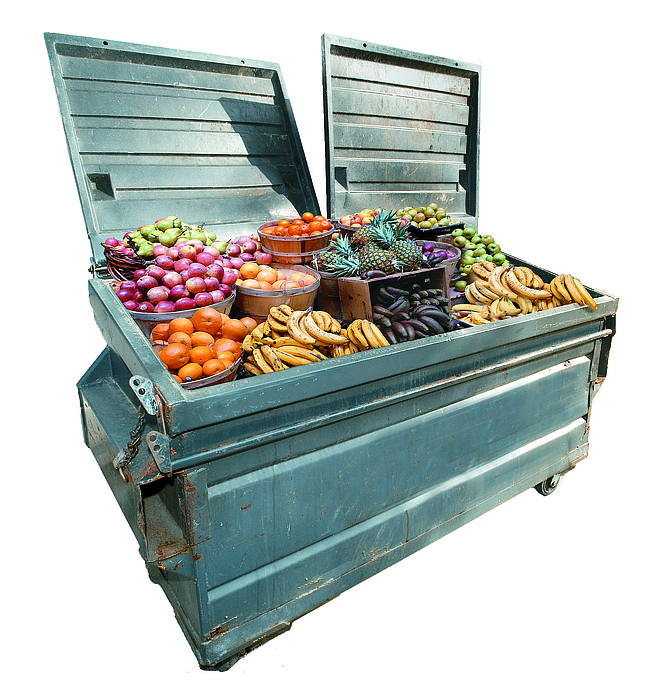

“You’re eating bug excrement.”
Stephen Facciola and I are standing in the parking lot of a Middle Eastern grocery in disheartening Anaheim. The streets are eight lanes wide. The blocks, a mile long. The air is hot, humid, smoggy. Strip malls and traffic stretch on and on to the hazy horizon. Facciola has just handed me a chewy white square of Iranian candy that tastes mostly of rose water.
The bug excrement, the gaz, gives the candy some of its texture and sweetness. Actually, it’s called Gaz of Khonsar. The jumping plant louse of Iran, Syamophila astragalicola, sucks sap from a plant, a relative of locoweed, and excretes the gaz. Peasants harvest it in late August. Who knows if they’ll be harvesting it next year, or the year after? The world is changing.”
By Abe Opincar, Nov. 22, 2000 | Read full article
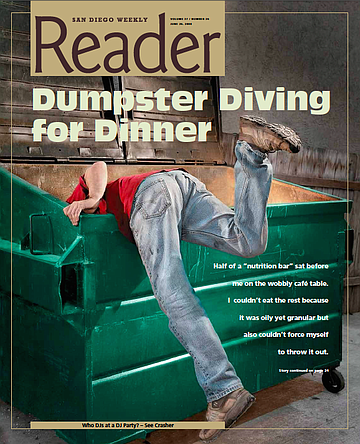
Freegan harvest
Half of a “nutrition bar” sat before me on the wobbly café table. I couldn’t eat the rest because it was oily yet granular but also couldn’t force myself to throw it out. I had arranged to meet freegans at the Other Side coffeehouse on 30th and Lincoln. If they saw me toss out good food, they’d probably think, yeah, another wasteful American. Glancing around to make sure they hadn’t arrived, I wadded the bar up in its foil wrapper and whisked it into an overfilled trash can.
By Ollie, June 25, 2008 | Read full article
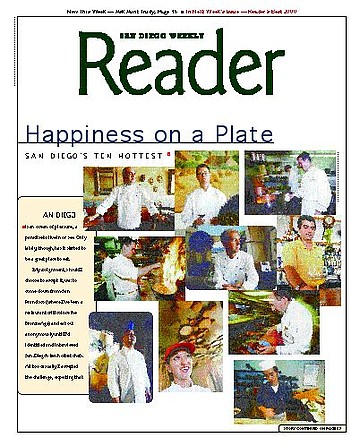
San Diego is an ocean of pleasures, a paradise to live in or see. Only lately, though, has it started to be a great place to eat.
My assignment, should I choose to accept it, was to come down from San Francisco (where I’ve been a restaurant critic since the Bronze Age) and eat out anonymously until I’d identified and interviewed San Diego’s ten hottest chefs. All too casually, I accepted the challenge, expecting that n six or seven weeks I’d be able to find 30-odd solid candidates and winnow down from there. Little did I realize what a desert I’d be trekking.
By Naomi Wise, Sept. 28, 2000 | Read full article

Restaurant staff gab and gobble.
Travis Murphy, also a cook, planned the staff’s daily dinner. At Nine-Ten, he said, the hardest part of arranging the staff meal, also called the “family meal,” was “to find something to use. The biggest challenge is protein. I have to improvise with what’s extra. Basically, we have to scavenge around. The family meal is…what’s the word I want? Spontaneous.” Traditionally, staff meals are many times improvisational works.
By Shari McCullough, Jan. 22, 2004 | Read full article
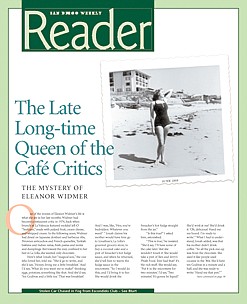
A life in food and literature remembered.
One of the ironies of Eleanor Widmer's life is what she ate in her last months. Widmer had become a restaurant critic in 1974, back when brunch at La Valencia featured molded Jell-O "Seafoam," made with pulped fruit, cream cheese, and whipped cream. In the following years, Widmer had dined on Japanese donburi and barbecue ribs, Peruvian anticuchos and French quenelles, Turkish baklava and Indian raitas, fresh pastas and moles and dumplings. But toward the end, confined to her bed in La Jolla, she wanted only chocolate.
By Jeannette DeWyze, Nov. 23, 2005 | Read full article
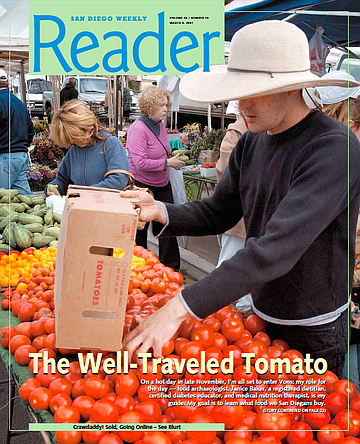
Do you know where your dinner comes from?
On a hot day in late November, I'm all set to enter Vons: my role for the day — food archaeologist. Janice Baker, a registered dietitian, certified diabetes educator, and medical nutrition therapist, is my guide. My goal is to learn what food we San Diegans buy. I want to understand what should be an uncomplicated question: Where does that food — displayed in unrepentant quantities at supermarkets, fast-food chains, soup-and-salad lines — come from?
By Thomas Larson, March 8, 2007 | Read full article



“You’re eating bug excrement.”
Stephen Facciola and I are standing in the parking lot of a Middle Eastern grocery in disheartening Anaheim. The streets are eight lanes wide. The blocks, a mile long. The air is hot, humid, smoggy. Strip malls and traffic stretch on and on to the hazy horizon. Facciola has just handed me a chewy white square of Iranian candy that tastes mostly of rose water.
The bug excrement, the gaz, gives the candy some of its texture and sweetness. Actually, it’s called Gaz of Khonsar. The jumping plant louse of Iran, Syamophila astragalicola, sucks sap from a plant, a relative of locoweed, and excretes the gaz. Peasants harvest it in late August. Who knows if they’ll be harvesting it next year, or the year after? The world is changing.”
By Abe Opincar, Nov. 22, 2000 | Read full article

Freegan harvest
Half of a “nutrition bar” sat before me on the wobbly café table. I couldn’t eat the rest because it was oily yet granular but also couldn’t force myself to throw it out. I had arranged to meet freegans at the Other Side coffeehouse on 30th and Lincoln. If they saw me toss out good food, they’d probably think, yeah, another wasteful American. Glancing around to make sure they hadn’t arrived, I wadded the bar up in its foil wrapper and whisked it into an overfilled trash can.
By Ollie, June 25, 2008 | Read full article

San Diego is an ocean of pleasures, a paradise to live in or see. Only lately, though, has it started to be a great place to eat.
My assignment, should I choose to accept it, was to come down from San Francisco (where I’ve been a restaurant critic since the Bronze Age) and eat out anonymously until I’d identified and interviewed San Diego’s ten hottest chefs. All too casually, I accepted the challenge, expecting that n six or seven weeks I’d be able to find 30-odd solid candidates and winnow down from there. Little did I realize what a desert I’d be trekking.
By Naomi Wise, Sept. 28, 2000 | Read full article

Restaurant staff gab and gobble.
Travis Murphy, also a cook, planned the staff’s daily dinner. At Nine-Ten, he said, the hardest part of arranging the staff meal, also called the “family meal,” was “to find something to use. The biggest challenge is protein. I have to improvise with what’s extra. Basically, we have to scavenge around. The family meal is…what’s the word I want? Spontaneous.” Traditionally, staff meals are many times improvisational works.
By Shari McCullough, Jan. 22, 2004 | Read full article

A life in food and literature remembered.
One of the ironies of Eleanor Widmer's life is what she ate in her last months. Widmer had become a restaurant critic in 1974, back when brunch at La Valencia featured molded Jell-O "Seafoam," made with pulped fruit, cream cheese, and whipped cream. In the following years, Widmer had dined on Japanese donburi and barbecue ribs, Peruvian anticuchos and French quenelles, Turkish baklava and Indian raitas, fresh pastas and moles and dumplings. But toward the end, confined to her bed in La Jolla, she wanted only chocolate.
By Jeannette DeWyze, Nov. 23, 2005 | Read full article

Do you know where your dinner comes from?
On a hot day in late November, I'm all set to enter Vons: my role for the day — food archaeologist. Janice Baker, a registered dietitian, certified diabetes educator, and medical nutrition therapist, is my guide. My goal is to learn what food we San Diegans buy. I want to understand what should be an uncomplicated question: Where does that food — displayed in unrepentant quantities at supermarkets, fast-food chains, soup-and-salad lines — come from?
By Thomas Larson, March 8, 2007 | Read full article
Comments